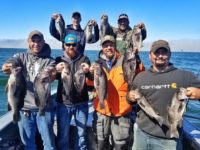Late June and early July mark one of the great bug events on the Williamson River when that largest of the mayflies, the Hexegenia, throw their shadows on the water.
If the Hex hatch happens, it happens at dusk.
Till then we would fish streamers.
A bubble line. A trail of white foam. Jagged boulders on each side of the tailout and a ridge of broken basalt visible beneath the surface.
“The thing we do here, Gary, is cast to the soft water, let the current pull the line tight, then feed it to the tongue, let 10 feet out, then strip back with two pulls and a pause.”
Craig Schuhmann, a Klamath Falls-based fishing guide and the editor of Flyfishing & Tying Journal, was on the sticks. Larry Zeilstra was in the stern seat and I was in the bow, knees wedged in the casting brace.
Craig began ribbing me about fishing an “old” fiberglass fly rod, but then we remembered he fishes out of a fiberglass drift boat and we all laughed.
A tributary of Upper Klamath Lake, the Williamson River drains about 3,000 square miles of southern Oregon. Connected to the food-rich lake, the trout migrate out to feed and then back to cool off in summer.
I had forgotten to bring a sinking line. Craig switched a reel off one of his rods for me and the 5-weight line was well matched to the glass.
On the business end was a claret leech, tied sparse in the southern Oregon style.
On maybe the third cast, a fish tugged at the fly while the line was bellied. Downstream in the next hole, a fish took the fly at the end of the swing. This time the rod loaded with a good fish. It fought hard in the cool water, jumped twice and, long and muscular showed itself off the gunwale before its last run.
In the net, it was steelhead in miniature. Nineteen inches of Klamath Lake-fed worthy Williamson rainbow, a landlocked Klamath Basin steelhead, back upriver to escape the heat of the lake.
A breeze blew up the river canyon, cooling us a bit in the 101-degree heat. We drifted down a couple of runs and I fired a cast at a No Trespassing sign, threw an upstream mend and let the ponderous current pull the line tight and swing through the hole, probably 5 feet deep with a basalt ridge behind that broke the surface of the river.
A fish plucked, pulled out 20 inches of shock loop and charged the boat then blasted past under a ledge. Gathering the line in my mouth, stripping hard to stay taut, I just had it under control when all the line burned out again through my lips, through my fingers and the fish was back on the reel, the backing laid bare on the spool.
Instead of jumping, it wallowed down deep and I saw it twice before the hook pulled out, a 6-pounder at least.
Shaking, I felt of the tippet, cut it back 4 inches and retied.
After I brought a 20-inch rainbow to hand, one of my best fish of the year, I lost three more big fish in a row.
Craig powered us down into the frog water and we took refuge in the shadow of a low ridge. A fine place to hesitate. A few of the big yellow mayflies began to show, struggling at the surface of the dark water then, drying their wings, breaking free and flying.
I switched to a graphite rod on which I had tied a 3X leader and a big yellow parachute Hex imitation. Craig handed me a Floating Hex Nymph originated by the late Klamath tyer Dick Winter.
We cast to the banks where trout were beginning to rise now that the sun was low in the sky.
A 5-mile float offers time for reflection. We watched trains, the cars flashing by on the tracks and mirrored in the river. One image in my mind is a 4-pound rainbow 3 feet above the surface, its red-banded body reflected in the water it has just burst out of at the moment the fly came out of its lip. Trout fishing in Central Oregon is an embarrassment of riches. Sample the Williamson, hold its bright treasure for a few moments, and let it slip back through your fingers.
Trout boiled along each bank. We cast to rise rings. In a hot summer evening punctuated by 21 grabs and a dozen battles and five fish brought to my hand, the Hex hatch was a frantic moment when we measured our casts, lost track of our flies and struck at sounds and splashes.
We floated the last half-mile in full dark, down through narrow runs carved out of basalt, beneath a bridge, beneath bonfire lights in the mirror of sky.
Gary Lewis is the host of “Frontier Unlimited TV” and author of “Fishing Central Oregon,” “Fishing Mount Hood Country” and other titles. Contact Gary at www.garylewisoutdoors.com.
Credit: Source link































